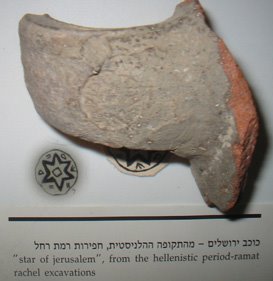 Photo is courtesy of Mira Dror, curator of the Tax Museum in Jerusalem, Israel.
Photo is courtesy of Mira Dror, curator of the Tax Museum in Jerusalem, Israel.The following paragraph is from Dr. Asher Eder’s book The Star of David, which was published in 1987 in English in Jerusalem by Rubin Mass Ltd. The publication here is courtesy of Oren Mass
1. A BRIEF HISTORY
In ancient times, most of the designs on ornaments and seals showed animals or flower motifs, or simple geometric lines such as strokes, circles and squares. True, some show six-petalled flowers or rosettes, as on this Egyptian seal from the third millennium B.C.E.:fig.1 Egyptian seal [not shown here]
But since similar designs with any number of petals – ranging from 5 to12 – were in use throughout the millenniums, we cannot say that those which showed six petals imply a connection with the hexagram, a figure composed of two intersecting equilateral triangles.
While archaeological finds showing the above motif abound, astoundingly few show pentagrams or hexagrams. This may indicate that the few artists who designed or used them had developed abstract, perhaps mathematical or geometrical concepts far beyond the scopes of simple hunting or farming societies. These artists probably belonged to circles inaugurated into the higher, or priestly, wisdom of their cultures.
While the pentagram can be seen as an abstract depiction of Man's stature, with his head above legs and arms, the design of the hexagram suggests an awareness of polarities as one of the characteristics of our world, and perhaps even of the Creator.
A lack of archaeological findings is, of course, no proof that things did not exist. Yet it is remarkable that the oldest known pentagram dates back to the third millennium B.C.E. (for more details, see chapter 27), while artifacts with hexagrams appear much later. A shard of pottery with a design resembling part of a hexagram, found in Gezer by Macalister, dates from the second half of the second millenium B.C.E.:fig.2 Gezer by Macalister [not shown here]
However, it is doubtful whether this drawing actually depicts a hexagram, as sometimes suggested; for the angles of this figure are each of a different degree. This fact rather indicates a decorative zig-zag line around a circle, with probably seven points.
the oldest undisputed example [of a hexagram] is on a seal from the seventh century B.C.E. found in Sidon and belonging to one Joshua ben Asayahu", as Prof. Scholem points out in his standard work Kabbalah. The name Joshua ben Asayahu, being a typical Hebrew name, links it to the Jewish culture.
Then, E.R. Goodenough claims, in his monumental work on “Jewish symbols of the Greco-Roman Period” (vol. 1, p.68), that he found a hexagram on the lintel of a Jewish tomb near Beth Guvrin, from the Hellenistic, pre-Maccabean period.
Quite convincing is then the artifact from Ramat-Rahel near Jerusalem. It is from the fourth century B.C.E., the end of the Persian or the beginning of the Greek period in Israel, and clearly shows a hexagram, with ancient Hebrew characters in lower corners reading YHD (yahad). They stand for Yehudah - Judea in English:
Another artifact found in Israel is a jar handle impressed with a hexagram, probably used as a royal seal. It dates back to the second century B.C.E., that is, the Maccabean period. It is also on display in the Israel Tax Museum, Jerusalem.
2 comments:
You need to tell who this Macalsitar guy is....I am doing research on this and I need info. Add some more info please. Rating: 2 out of 5.
http://en.wikipedia.org/wiki/R._A._Stewart_Macalister
Post a Comment